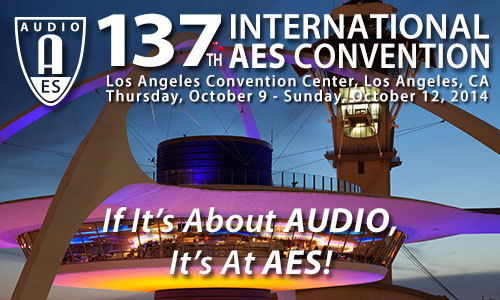AES Los Angeles 2014
Poster Session P16
P16 - Applications in Audio: Part 2
Saturday, October 11, 3:00 pm — 4:30 pm (S-Foyer 1)
P16-1 General Volterra and Swept-Sine Diagonal System Estimation and Modeling Performance—Russell H. Lambert, Harman International - South Jordan, UT, USA
Volterra system modeling performance results are given for various scenarios using both fully-determined and under-determined models. Three nonlinear system estimation methods are presented and compared including a novel and efficient Farina-type Hammerstein algorithm. The diagonal-only Hammerstein methods will not model off-diagonal nonlinear energy for general uncorrelated inputs but will model correlated inputs to some degree. The data matrix estimation methods work for generic input signal types. The nonlinear system must be fully determined to yield best results, but the diagonal-only models are more practical for applications having significantly long memory channels.
Convention Paper 9185 (Purchase now)
P16-2 Downward Compatibility Configurations when Using a Univalent 12 Channel 3D Microphone Array Design as a Master Recording Array—Michael Williams, Sounds of Scotland - Le Perreux sur Marne, France
It can be shown that Microphone Array Design applied to a 12-channel 3D microphone array can create a master recording array design that will generate downward compatible signals that satisfy most of the present-day univalent lower order channel/loudspeaker configurations. The implementation of this compatibility oriented array design requires no matrixing or processing of the channel signals, while still maintaining the integrity of the overall sound field architecture. This compatibility approach to 3D array design produces a master recording system that can be adopted for an overall production, eventually to be distributed using several different media formats (stereo, DVD, Blu-ray, 3D, etc.). However this approach can also be used as a consumer choice function within a global master recording or file downloading facility.
Convention Paper 9186 (Purchase now)
P16-3 Relative Influence of Spectral Bands in Horizontal Front Localization of White Noise—Tomomi Sugasawa, University of Aizu - Aizu-Wakamatsu, Fukushima, Japan; Jie Huang, University of Aizu - Aizuwakamatsu City, Japan; Julian Villegas, University of Aizu - Aizu Wakamatsu, Fukushima, Japan
The relationship between horizontal-front localization and the energy in different spectral bands is investigated in this paper. Specifically, we tried to identify which spectral regions produced changes in the judgments of the position of a white noise, when each band was removed from the noise presented through a front loudspeaker and presented via side loudspeakers. These loudspeakers were set at left and right from the front-midsagittal plane of the listener. Participants were asked to assess whether the noise was coming from the front loudspeaker as bands were moved from front to side loudspeakers. Results from a pilot study suggested differences in the relative importance of spectral bands for horizontal-front localization.
Convention Paper 9187 (Purchase now)
P16-4 Acoustic Digital Communication for Identification Systems—Sergio Vazquez, Universidad Nacional de Tres de Febrero - Buenos Aires, Argentina; Virtual Things
In this paper a secure, low cost, energy efficient, robust digital communication system for identification purposes is presented. An alternative to magnetic stripe cards, Bluetooth LE, and NFC (Near Field Communication) that requires no specific hardware, making it compatible with almost every smartphone or portable device that has a working loudspeaker and is capable of reproducing audio. While previous works on the subject established the possibility to transmit digital data over the air using acoustic waves, this paper focuses on its implementation.
Convention Paper 9188 (Purchase now)
P16-5 How Critical Listening Exercises Complement Technical Courses to Effectively Provide Audio Education for Engineering Technology Students—Mark J. Indelicato, Rochester Institute of Technology - Rochester, NY, USA; Clark Hochgraf, Rochester Institute of Technology - Rochester, NY, USA; Sungyoung Kim, Rochester Institute of Technology - Rochester, NY, USA
Music is important to many aspects of our lives including student life at an institution of higher education. Combining music with academic coursework and programs therefore can be an effective way of engaging students to embrace academic programs and be successful in higher education. Some institutions have purposely incorporated audio engineering into technical programs as a way to not only create interest but to increase retention. Others have created music and technology programs and options, leveraging the student passion for music and keen interest in engineering. This paper discusses the benefit of combining music, technology, and engineering into higher education and, in particular, how the development of critical listening skills is key to the success of such a curriculum.
Convention Paper 9189 (Purchase now)
P16-6 On the Acoustics of Alleyways—Regina E. Collecchia, Stanford University - Stanford, CA, USA; SoundHound, Inc. - Santa Clara, CA, USA; Jonathan S. Abel, Stanford University - Stanford, CA, USA; Sean Coffin, Stanford University - Stanford, CA, USA; Eoin Callery, Stanford University - Stanford, CA, USA; Yoo Hsiu Yeh, Stanford University - Stanford, CA, USA; Kyle Spratt, University of Texas, Austin - Austin, TX, USA; Julius O. Smith, III, Stanford University - Stanford, CA, USA
Alleyways bounded by flat, reflective, parallel walls and smooth concrete floors can produce impulse responses that are surprisingly rich in texture, featuring a long-lasting modulated tone and a changing timbre, much like the sound of a didgeridoo. This work explores alleyway acoustics with acoustic measurements and presents a computational model based on the image method. Alleyway response spectrograms show spectral zeros rising in frequency with time and a modulated tone lasting noticeably longer than the harmonic series associated with the distance between the walls. With slight canting of the walls and floors to produce the long lasting modulated tone, the image method model captures much of this behavior.
Convention Paper 9190 (Purchase now)
